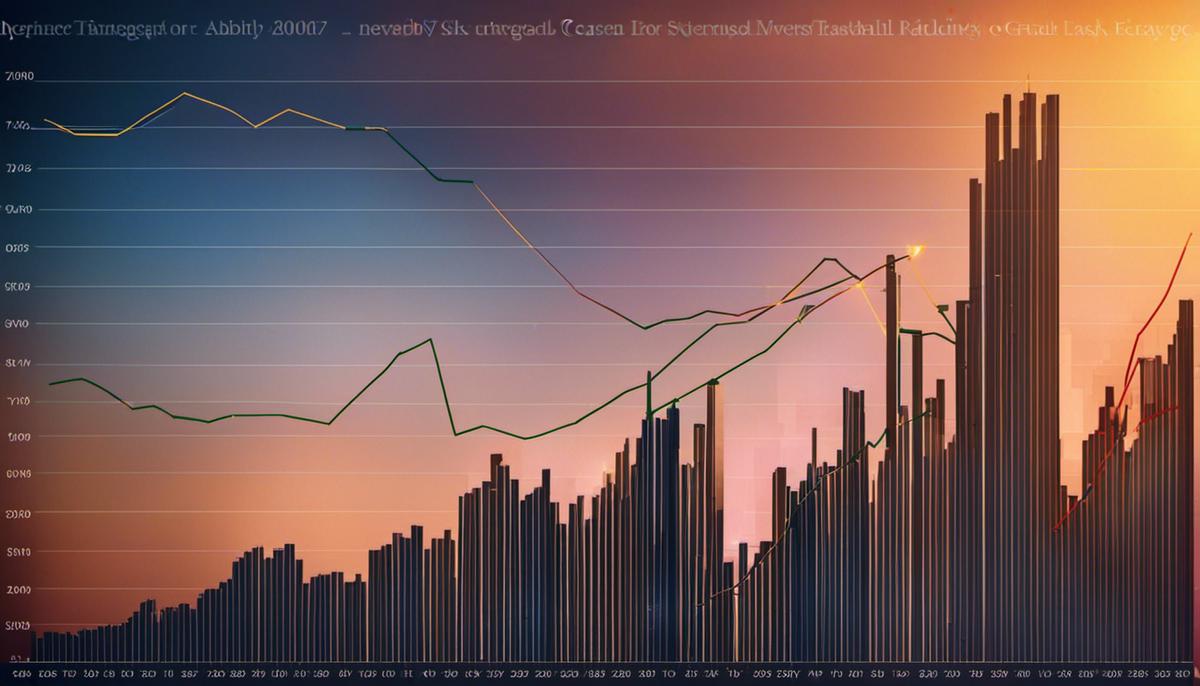BetterYouJourney.com is a participant in the Amazon Services LLC Some of the links in our posts are affiliate links. Click here to see full Disclosure.
In the intricate world of investing, understanding the correlation between risk and return can make all the difference between fleeting losses and sustained financial growth. Delving into this realm, specifically the sector of low-risk investments, provides valuable insights every investor should be equipped with. Grasping the equilibrium of risk reward, exploring various types of low-risk investments, comparing potential returns, and learning how to create a diverse low-risk portfolio forms the foundation of wise investing. Navigating through this financial labyrinth doesn’t come naturally to all, but taking the time to comprehend these fundamentals can equip you with the knowledge needed to make smart investing decisions and align them with your risk tolerance level.
Understanding Risk and Reward in Investing
Understanding Risk and Reward in Investing
Risk and reward are crucial concepts in investing. In simple terms, risk pertains to the degree of uncertainty about the return on an investment. It represents the possibility of an investor losing some or all of their original investment. On the contrary, reward refers to the potential return or profit an investor can gain from an investment.
The concept of risk and reward is grounded in the thought that the higher the risk, the higher the potential return. This belief is based on the fundamental principle that investors need to be compensated for taking on additional risk. Conversely, investments that carry lower levels of risk generally provide lower returns.
However, not all risks are the same. There are two broad categories of investing risks: systematic risks and unsystematic risks. Systematic risks are ones that affect the entire market, such as inflation rates, political instability, or changes in interest rates. Unsystematic risks, meanwhile, pertain to company-specific events such as labor strikes or management changes and can be mitigated through diversification.
Correlation Between Risk and Return
There is a direct correlation between risk and return in the investing world. For an investment to yield higher returns, an investor has to be willing to accept a higher level of risk. For example, stocks have historically offered higher long-term returns than safer options like bonds, but they also come with a higher risk of loss.
For low-risk investments, the potential for return is generally lower. These types of investments are suited for risk-averse individuals who are more concerned with preserving their initial investment than with earning a high return.
Risk Tolerance and Investment Decisions
Risk tolerance refers to the degree of variability in investment returns that an investor is willing to withstand. It is a critical component of any investment strategy, as it sets the parameters for how much risk an investor is comfortable taking.
Different people have different risk tolerances. An individual’s risk tolerance can depend on factors such as age, income level, financial goals, and personal comfort with uncertainty. An investor’s risk tolerance level largely influences their investment decisions, including where to invest their money and how to diversify assets.
Introduction to Low-Risk Investment Options
For risk-averse investors or those on the brink of retirement, low-risk investments are often the best option. These investment types prioritize the protection of capital over the potential for high returns. Among low-risk investments, Treasury bonds issued by the U.S. government are among the safest, offering guaranteed returns and the full backing of the U.S. Federal government.
Certificates of Deposit, known as CDs, are also popular low-risk investments, offering a fixed interest rate over a predetermined period. Money Market Accounts and Savings Accounts are two more options that provide steady if somewhat limited, returns. Mutual funds, specifically bond and money market funds, appeal to those seeking to minimize risk due to their diversified mix of assets funded by many different investors.
Despite their lower returns, these low-risk options echo the sentiment “slow and steady wins the race”, particularly when the key focus is on preserving capital.

Types of Low-Risk Investments
Exploring Certificates of Deposit (CDs)
Certificates of Deposit (CDs) are a popular form of low-risk investment provided by banks and credit unions. When you buy a CD, you’re essentially letting the bank borrow your money for a fixed “term length”. In return, the bank promises you a specific interest rate. These term lengths can vary from a few months to several years, with longer terms typically offering higher interest rates. The primary risks of CDs involve the potential for inflation to surpass the interest rate or the need to access your money before the term ends, which can lead to penalties.
Government Bonds
Government bonds are issued by the federal government and are considered one of the safest investment options. They have the backing of the full faith and credit of the U.S. government, so the risk of default is essentially nonexistent. Government bonds generally pay interest semi-annually and return the face value of the bond upon its maturity. The downside is that they may not offer as high a return as other more risky assets, but they’re an excellent choice for conservative investors looking to preserve capital.
Treasury Inflation-Protected Securities (TIPS)
Treasury Inflation-Protected Securities (TIPS) are a special kind of government bond that is indexed to inflation. The principal value of TIPS increases with inflation as measured by the Consumer Price Index (CPI). When TIPS mature, you are paid the adjusted principal or original principal, whichever is greater. TIPS can provide an effective hedge against inflation, ensuring that your investment keeps pace with the general rise of prices over time.
Municipal Bonds
Municipal bonds, or “munis”, are issued by states, cities, and local governments to fund various projects, such as constructing schools or highways. The interest income from most municipal bonds is exempt from federal taxes, and sometimes state and local taxes as well, making them particularly attractive to investors in higher tax brackets. Despite their tax advantages, the interest rates on municipal bonds are typically lower than those on taxable bonds, and they may carry more risk if the issuing entity runs into financial difficulties.
Savings Accounts
Savings accounts are a simple and accessible low-risk investment option. They offer a very stable return, as the interest rate is usually fixed over a certain period. Although the returns are generally lower than other investment options, the risk is also minimal due to the fact that savings accounts are insured by the Federal Deposit Insurance Corporation (FDIC) for up to $250,000 per depositor. The only key risk to consider is inflation, as the interest rates on savings accounts may not always keep pace.
Understanding Money Market Mutual Funds
When we talk about low-risk investments, Money Market Mutual Funds often come to the conversation. These funds mainly concentrate their investments in short-term, high-quality securities, like U.S. Treasury bills or commercial papers. Their primary objective is to maintain a steady value of $1 per share whilst typically disbursing interest in the form of dividends. While they aren’t technically insured, Money Market Mutual Funds are considered extremely safe. But, unlike a money market deposit account, they lack Federal Deposit Insurance Corporation (FDIC) protection. Thus, keep in mind, although the risk of losing money is relatively low, it nevertheless still exists.

Comparing Returns of Low-Risk Investment Options
Insighful Historical Returns of Low-Risk Investment Options
By analyzing the historical returns of different low-risk investment options, we can gain some valuable insights into their possible future performances. While previous performance isn’t a foolproof predictor of future outcomes, it does provide investors a reference point from which to gauge potential returns.
Take bonds, for instance, they are seen as a solid investment, especially those issued by stable governments. Annually, the average return for long-term government bonds has been about 5% to 6%. If you are looking for less risk, Treasury bonds yield lower returns, usually around 1% to 3%, contingent on the bond’s maturity date.
Low-risk options like savings accounts and Money Market funds may provide minimal yields, but they are safe and often yield returns under 1%. They not only provide constant interest income but also allow easy access to funds.
For slightly higher yields, consider Certificates of Deposit (CDs). They usually offer between 1% and 2%, based on the term and the bank. With the safety of FDIC insurance, like savings accounts, they make a very secure investment option.
Inflation and Low-Risk Investment Options
While these low-risk investment options can provide steady income, it’s essential to factor inflation into the equation. Over time, inflation eats away at the value of money. A return that might seem appealing now might not be as attractive after adjusting for inflation.
For instance, if a savings account offers a 1% return, but the inflation rate is 2%, the real return is a negative 1%, meaning you would lose purchasing power over time. This makes it essential to consider historical inflation rates and expectations for future inflation when reviewing potential returns.
An Overview of Low-Risk Investing
Utilizing low-risk investment options can be a powerful part of any investor’s financial strategy, and can be particularly beneficial for those nearing retirement, or those who prefer to avoid more volatile markets. These secure options generate a steady income with a low potential for loss.
Investments such as bonds, particularly government bonds, are a great way to balance out some of the unpredictability of the stock market within a diversified portfolio. They also offer steady interest income, which can either be reinvested or utilized as a reliable cash flow.
Safety and liquidity are hallmarks of savings accounts, money market funds, and certificates of deposit (CDs). Although CDs may be subject to early withdrawal penalties, these investment choices offer easy access to cash for unexpected expenses, making them an important part of an investment portfolio.
When considering low-risk investment options, investors should assess their own risk tolerance, the contribution of the potential investment to their overall financial plan, and the impact of inflation on returns. This critical assessment will help guide them to the most suitable low-risk investments for achieving their financial objectives.

Creating a Diversified Low-Risk Investment Portfolio
Delving Deeper into Low-Risk Investments
So, what exactly are low-risk investments? They’re financial tools and methods that aim to protect your initial investment, acting like a safety net for your money. These are perfect solutions for cautious investors who prioritize preserving their initial investment over seeking high returns. Low-risk investments can involve a range of financial instruments such as bonds, mutual funds, fixed annuities, and even dividend-paying stocks. The goal is that these investments provide a level of profit, while keeping the risk of potential loss to a minimum. This makes them a particularly good choice for protecting retirement funds, emergency savings, or any assets that you don’t want to expose to unnecessary risk.
Building a Diversified Investment Portfolio
A diversified investment portfolio is a mix of different kinds of investments aimed at minimizing risks and maximizing returns. This strategy involves distributing investments across various financial instruments, sectors, geographical regions and currencies, to secure a broad market exposure and to limit potential losses. For example, if one sector or asset is performing poorly, gains in other sectors can offset the losses. A diversified low-risk investment portfolio may incorporate bonds, treasury notes, blue-chip stocks, real estate investment trusts (REITs), and index funds.
The Benefits of Diversification
Diversification can help manage risk and reduce the potential for significant losses. By spreading investments across various types of financial instruments, you’re less likely to experience drastic drops if one sector or market struggles. Moreover, diversification can provide an investor with more steady, predictable returns, increasing the chances of reaching their long-term financial goals.
Strategies for Diversifying Low-Risk Investments
Achieving a diversified low-risk investment portfolio requires strategic planning, research, and ongoing maintenance. Here are several strategies to consider:
- Asset allocation: Assign a certain proportion of your portfolio to different asset classes such as stocks, bonds, and other low-risk investments. The exact allocation will depend on your financial goals and risk tolerance.
- Invest in mutual funds or ETFs: These investment products pool money from many investors to create a diversified portfolio of stocks, bonds, or other assets. This can be an efficient way to diversify without buying individual securities.
- Consider geographical diversification: It may be beneficial to invest in international markets and different geographical regions, reducing dependence on the performance of your home country’s economy.
- Regular rebalancing: Over time, some investments may grow faster than others, leaving your portfolio unbalanced. Regular rebalancing can ensure that your portfolio stays aligned with your investment goals and risk tolerance.
Maintaining and Adjusting a Low-Risk Portfolio
Maintaining a low-risk portfolio involves regular monitoring and adjustments to align with your investment goals, economic developments, and market trends. Investors may need to rebalance their portfolios periodically, based on changes in the market conditions or their financial goals. Diversification isn’t a one-time activity but an ongoing process of active portfolio management.
Time is also an important factor in managing a portfolio. Over the long term, lower-risk investments gradually build wealth, but they may appear to grow very slowly over the short term. If you’re approaching a time when you’ll need the money (such as retirement), it may be beneficial to shift more of your portfolio into lower-risk investments to protect what you’ve accumulated.
In conclusion
While low-risk investments may not provide the high returns of riskier assets, they offer a safer platform to grow wealth steadily. By diversifying a low-risk investment portfolio, you can achieve more stable returns and maintain financial security.

Indeed, mastering the art of low-risk investing can be a game-changer for individuals who wish to guard their capital while also making modest yet steady gains. A solid understanding of various investment instruments, their risk-reward profile, and their long-term performance against factors like inflation can vastly improve your financial prospects. Furthermore, creating and maintaining a diversified investment portfolio can spread the risk and increase the likelihood of a consistent performance. Investing doesn’t always have to be a high-risk gamble. A thoughtful, balanced, and educated approach can lead you down the path to financial stability and growth while minimizing potential losses.








